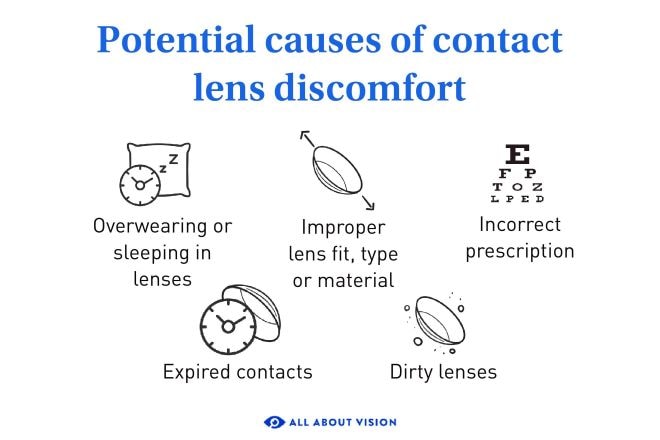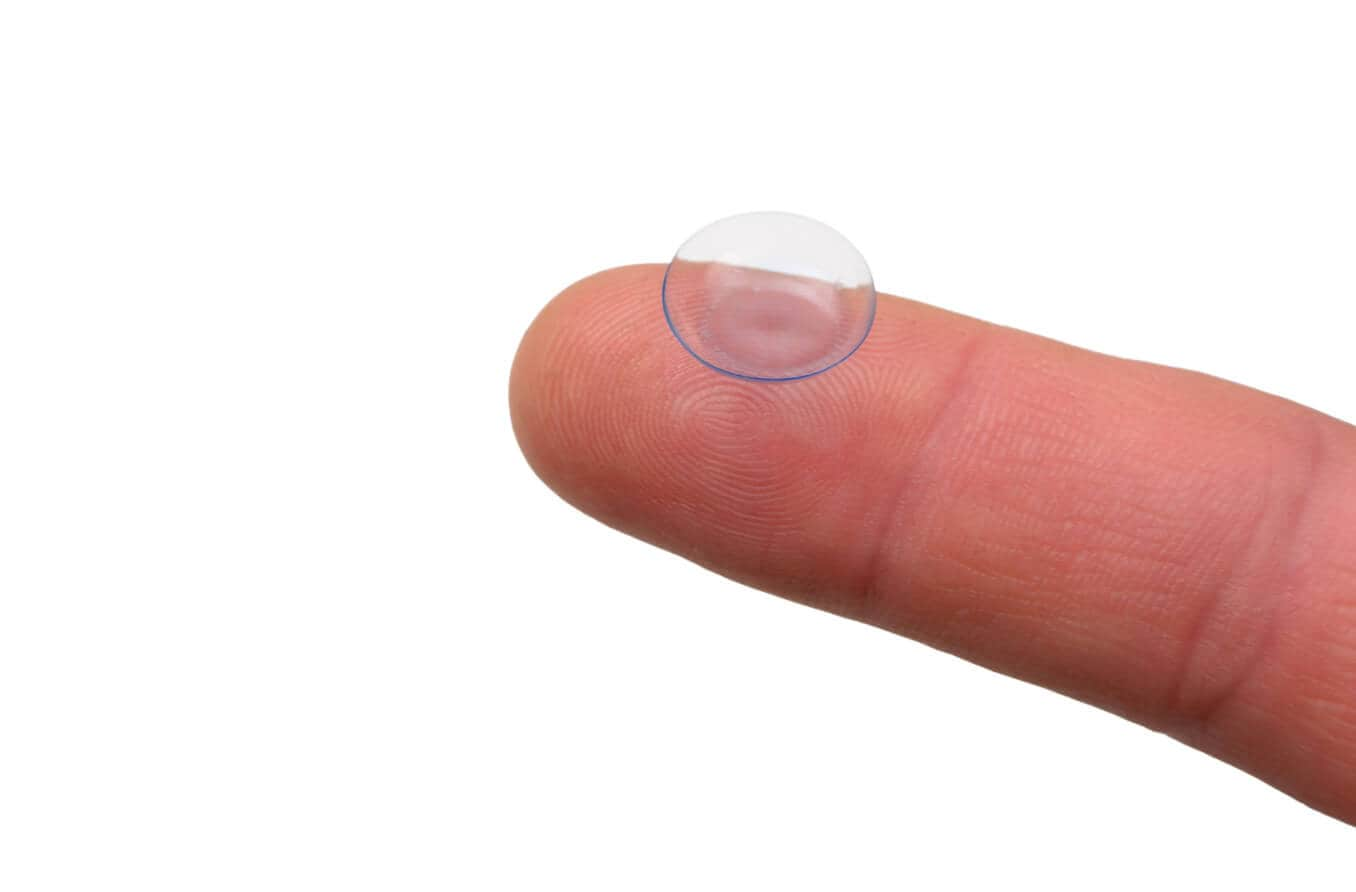Contact lenses and headaches
Many people rely on contact lenses for clear, comfortable vision. However, when they do not fit as they should or when certain eye issues accompany their use, contacts can cause headaches or discomfort over time.
Contact lenses are often used to correct vision problems, such as nearsightedness (myopia), farsightedness (hyperopia) and astigmatism. They sit on the eye and offer a wider range of vision than glasses, making them a popular choice for everyday wear. But for some people, lens use may contribute to headaches or migraine symptoms.
Ill-fitting contact lenses can cause issues that may lead to headaches or trigger migraine attacks. Other factors, like dryness and irritation, can also cause discomfort from wearing lenses.
If you have headaches while wearing your lenses, check the fit and prescription. You might also consider trying different lens types from your eye care provider. Additionally, small changes in how you use your lenses and your daily habits can boost comfort and reduce symptoms.
How contact lenses can cause headaches
Contact lenses can sometimes contribute to headaches when they don’t meet your eyes’ needs. Whether due to strain, dryness or vision changes, small issues with lens wear can add up and lead to discomfort.

Incorrect prescription
A wrong contact lens prescription may not harm your eyes in the long run, but it can cause discomfort. You might need to update your prescription if you have headaches or feel eye fatigue. In more severe cases, it can lead to eye strain that may cause symptoms, like discomfort, difficulty seeing, aching above the eyes or nausea.
Receiving the correct prescription is often all it takes to relieve the symptoms.
Eye strain from digital devices
Spending long hours on digital devices can lead to eye strain (asthenopia), especially for contact lens wearers. When using screens, people tend to blink less often, which can cause the eyes to feel dry, tired or irritated.
Poor screen habits, like staring too long without breaks or having dry eyes, can make these symptoms worse. In addition to blurry vision and watery eyes, eye strain can also cause headaches and discomfort.
Some ways to reduce eye strain for contact lens users include:
- Switch to glasses from time to time to allow your eyes to rest.
- Stick to proper cleaning habits of your contact lenses to prevent buildup and discomfort.
- Avoid sleeping in your lenses.
- Talk to your eye doctor if you notice redness, cloudy vision, tearing, light sensitivity or pain that doesn’t go away.
Presbyopia and aging
As we get older, it becomes harder for our eyes to focus on things up close. Known as presbyopia, this age-related change usually starts around age 40. Presbyopia can lead to eye discomfort, blurry vision when reading and headaches if lenses are not updated to match the changes in vision.
In addition to presbyopia, aging eyes may experience changes that affect how contact lenses fit and perform. These changes often need a more tailored approach with specific lens types and designs that support the visual needs of older adults. Special lenses, like multifocal or monovision contacts, can help make vision clearer and reduce the side effects of aging on your vision.
Astigmatism and contact lenses
Astigmatism happens when the front surface of the eye (the cornea) or the lens inside the eye has an uneven curve. This causes blurry or distorted vision, headaches and discomfort due to uneven light entry into the eye. Contact lenses can help correct astigmatism, but they may not always feel comfortable or provide sharp vision if they don’t fit well.
Some types of contact lenses may not offer clear or consistent vision for people with astigmatism, resulting in continued symptoms. However, certain types, such as toric contact lenses, stay in the correct position using features like edge weighting and thin zones, and newer designs have made them more effective and comfortable than before.
If your contacts feel uncomfortable or don’t enhance your vision, consult an eye care provider. They can recommend useful treatments for astigmatism.
Solutions to prevent headaches from contact lenses
Several strategies can help reduce the risk of headaches caused by contact lens wear. From keeping your prescription current to following healthy wear and care habits, these simple steps can make a big difference in how your eyes feel day to day.
Regular eye exams
Routine eye exams are an important part of keeping your vision clear and your eyes healthy. They help detect changes in your prescription and allow your eye doctor to check for signs of common eye problems. Even if you aren’t noticing any issues, some conditions can develop without early symptoms. Updating your contact lens prescription as needed can help prevent strain or discomfort that may lead to headaches.
Proper lens fit
Wearing contact lenses that do not fit well can cause discomfort and may lead to headaches. A poor fit can affect how the lens sits on the eye, leading to irritation, dry eyes and visual strain. According to research, uncomfortable contact lenses may even trigger migraine symptoms in some individuals. An eye care professional can help reduce these risks and enhance comfort during wear by ensuring a proper fit for your lenses.
Use of reading glasses
If you’re dealing with headaches caused by presbyopia, reading glasses may help relieve discomfort by reducing the strain on your eyes. These glasses improve near vision by helping light focus prior to reaching the eye, which makes it easier to see things up close.
Reading glasses are often recommended if you don’t have other conditions, like nearsightedness, farsightedness or astigmatism, and they can also be used while wearing your contact lenses. You can purchase readers without a prescription, but you may still need an eye exam to identify the exact strength needed. However, if you prefer a more precise option, prescription reading glasses can be a better option to match your individual visual needs.
Consider LASIK surgery
LASIK is a good choice for those who get headaches from contact lenses and want to avoid glasses. This procedure works by altering the shape of the cornea, allowing light to enter the eye with greater accuracy and enhancing focus and clarity. By correcting common refractive issues, like nearsightedness, farsightedness or astigmatism, LASIK can reduce or eliminate your dependence on contact lenses and help relieve the discomfort they sometimes cause.
However, it’s important to note that LASIK is not right for everyone. A stable vision prescription, healthy eyes and sufficient corneal thickness are a few of the factors your eye doctor will check to see if you’re a good candidate.
Lifestyle tips for contact lens wearers
A few simple lifestyle changes can make contact lens use more comfortable. These habits can also help ease the strain on your eyes. Staying hydrated, following instructions for lens care and giving your eyes regular breaks can all make a big difference.
Screen time management
Spending long hours on digital devices can wear out your eyes. These simple habits can help you stay more comfortable and protect your vision:
- Follow the 20-20-20 rule – Every 20 minutes, look at something 20 feet away for at least 20 seconds.
- Adjust the size of your text – Increase your font size to at least 12 to avoid squinting.
- Keep a healthy distance – Hold phones and tablets at least 13 inches from your eyes, and sit at least 20 inches from larger screens.
- Blink more often – Staring at screens can make you blink less, which may dry out your eyes. Remind yourself to blink.
- Match your lighting – Make sure room lighting isn’t much brighter or dimmer than your screen.
- Reduce glare – Use screen filters, adjust your settings and avoid sitting where light reflects off your screen.
- Adjust your setup – Keep the top of your screen at or below eye level, and angle it back. Sit with back support and feet flat.
- Attend yearly eye exams – Routine checkups can catch early signs of digital eye strain and other vision problems.
Hydration and eye care
Wearing contact lenses can lead to dry eyes. This is more likely when using screens for a long time or in dry conditions. When left unmanaged, this dryness may lead to discomfort and blurry vision. Practicing good hydration habits can help relieve symptoms and reduce the risk of dry eye syndrome.
Some ways to combat dry eyes include to:
- Use artificial tears.
- Stay hydrated by drinking plenty of water.
- Take breaks from screens.
- Use a humidifier to add moisture to dry indoor air.
- Make sure lenses fit well and stick to the advised wear times.
Hydrating your eyes is an easy and important step. It reduces eye strain and helps prevent issues with contact lenses.
When to see an eye care professional
If you experience headaches often while using contact lenses, it may indicate a problem. Issues like an outdated prescription, bad lens fit or dry eyes can lead to major discomfort if not taken care of.
A visit with an eye care professional can resolve many of these problems. An optometrist or ophthalmologist can evaluate your prescription and check for any underlying eye conditions that might be contributing to your symptoms. There are many options for your vision needs. You can switch to a different lens type, explore LASIK or use reading glasses. Your eye doctor will help you choose the best fit.
Regular eye checkups and healthy habits can enhance the comfort of wearing contact lenses. If your symptoms don’t improve or get worse, it’s a good idea to schedule an eye exam to find out what’s going on.







